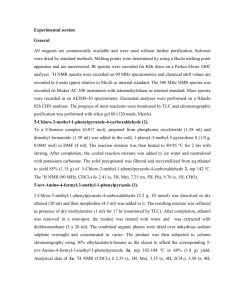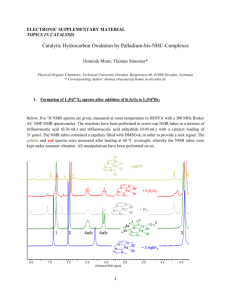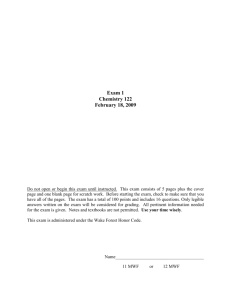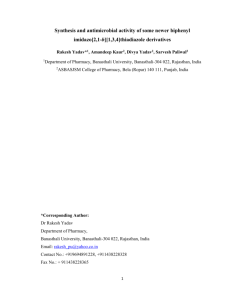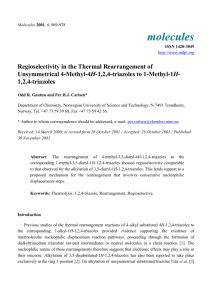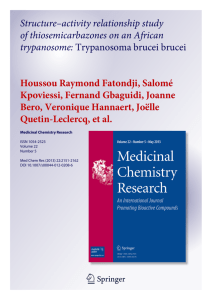Experimental Section - Royal Society of Chemistry
advertisement
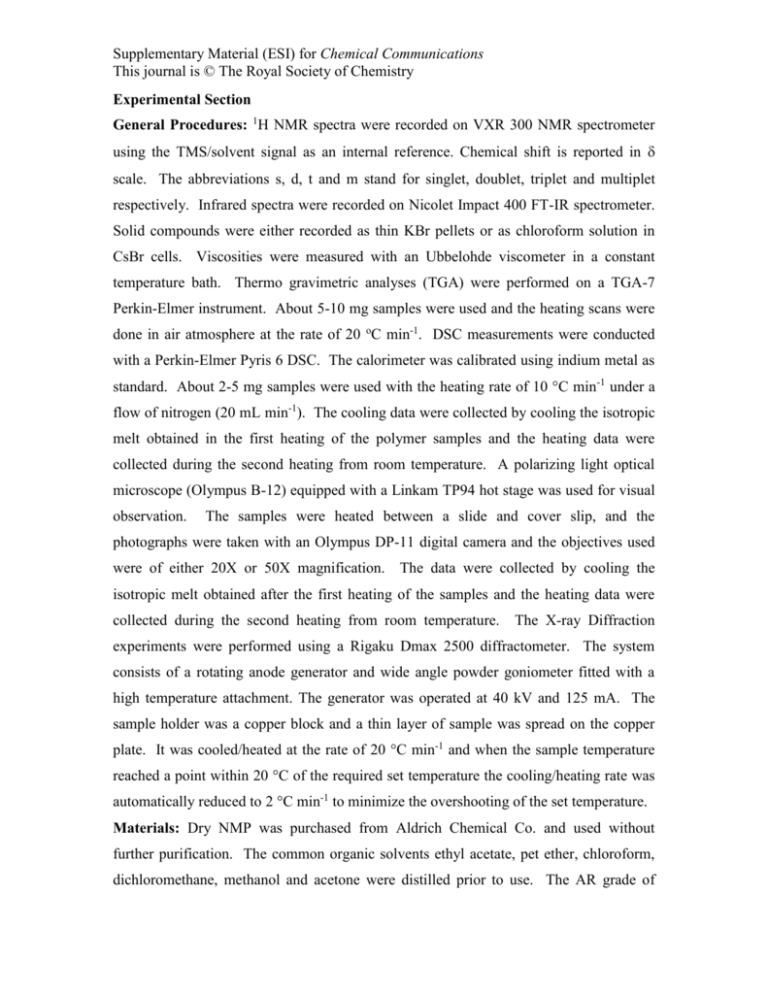
Supplementary Material (ESI) for Chemical Communications This journal is © The Royal Society of Chemistry Experimental Section General Procedures: 1H NMR spectra were recorded on VXR 300 NMR spectrometer using the TMS/solvent signal as an internal reference. Chemical shift is reported in scale. The abbreviations s, d, t and m stand for singlet, doublet, triplet and multiplet respectively. Infrared spectra were recorded on Nicolet Impact 400 FT-IR spectrometer. Solid compounds were either recorded as thin KBr pellets or as chloroform solution in CsBr cells. Viscosities were measured with an Ubbelohde viscometer in a constant temperature bath. Thermo gravimetric analyses (TGA) were performed on a TGA-7 Perkin-Elmer instrument. About 5-10 mg samples were used and the heating scans were done in air atmosphere at the rate of 20 oC min-1. DSC measurements were conducted with a Perkin-Elmer Pyris 6 DSC. The calorimeter was calibrated using indium metal as standard. About 2-5 mg samples were used with the heating rate of 10 °C min-1 under a flow of nitrogen (20 mL min-1). The cooling data were collected by cooling the isotropic melt obtained in the first heating of the polymer samples and the heating data were collected during the second heating from room temperature. A polarizing light optical microscope (Olympus B-12) equipped with a Linkam TP94 hot stage was used for visual observation. The samples were heated between a slide and cover slip, and the photographs were taken with an Olympus DP-11 digital camera and the objectives used were of either 20X or 50X magnification. The data were collected by cooling the isotropic melt obtained after the first heating of the samples and the heating data were collected during the second heating from room temperature. The X-ray Diffraction experiments were performed using a Rigaku Dmax 2500 diffractometer. The system consists of a rotating anode generator and wide angle powder goniometer fitted with a high temperature attachment. The generator was operated at 40 kV and 125 mA. The sample holder was a copper block and a thin layer of sample was spread on the copper plate. It was cooled/heated at the rate of 20 °C min-1 and when the sample temperature reached a point within 20 °C of the required set temperature the cooling/heating rate was automatically reduced to 2 °C min-1 to minimize the overshooting of the set temperature. Materials: Dry NMP was purchased from Aldrich Chemical Co. and used without further purification. The common organic solvents ethyl acetate, pet ether, chloroform, dichloromethane, methanol and acetone were distilled prior to use. The AR grade of Supplementary Material (ESI) for Chemical Communications This journal is © The Royal Society of Chemistry THF, chloroethyl formate, hydrazine hydrate and sodium azide were purchased from SD Fine Ltd and used as such. Synthesis: 4’-(Hydroxy-alkoxy)-biphenyl-4-carbonyl azide (Azide-3-8, n=3-8): The hydroxy carboxylic acid (1 equiv) was dissolved in minimum amount of THF and cooled to 0 C. To this was added triethyl amine (1 equiv) followed by chloroethyl formate (1 equiv) and the reaction mixture was stirred for 2 h at 0 C. Then was added saturated solution of sodium azide in water (5 equiv) and continued stirring for further 1 h. The reaction mixture was poured in water and the precipitated product was extracted with dichloromethane. The organic layers were combined, washed with water, dried over anhydrous sodium sulfate and concentrated at room temperature under reduced pressure to get the hydroxy carbonyl azide as white solid (Yield: 76-89%). The carbonyl azides were quite unstable in the solid state at room temperature. However, they were somewhat stable when dissolved in some common organic solvents like dichloromethane, chloroform, ethyl acetate etc. Hence they were dissolved in dichloromethane and stored in a refrigerator. Azide-3: Yield: 89%; 1H NMR (CDCl3, , ppm): 2.08 (m, 2H), 3.89 (t, 2H, 1JHH = 5.50 Hz), 4.08 (t, 2H, 1JHH = 6.1 Hz), 6.99 (d, 2H, 1JHH = 8.54 Hz), 7.59 (dd, 4H, 1JHH = 8.54 and 8.54 Hz), 8.05 (d, 2H, 1JHH = 8.54 Hz). IR (CHCl3, cm-1): 3402, 3052, 2985, 2942, 2136, 1734, 1682, 1603, 1522, 1255, 1185, 744. Azide-4: Yield: 83%; 1H NMR (CDCl3, , ppm): 1.8 (m, 2H), 1.94 (m, 2H), 3.75 (t, 2H, 1 JHH = 6.26 Hz), 4.07 (t, 2H, 1JHH = 6.26 Hz), 6.99 (d, 2H, 1JHH = 8.86 Hz), 7.6 (dd, 4H, 1 JHH = 8.86 and 8.55 Hz), 8.05 (d, 2H, 1JHH = 8.55 Hz). IR (CHCl3, cm-1): 3397, 3054, 2986, 2136, 1710, 1687, 1603, 1422, 1265, 1185, 895, 740. Azide-5: Yield: 89%; 1H NMR (CDCl3, , ppm): 1.56 (m, 2H) 1.64 (m, 2H), 1.86 (m, 2H), 3.69 (t, 2H, 1JHH = 6.1 Hz), 4.02 (t, 2H, 1JHH = 6.71 Hz), 6.97 (d, 2H, 1JHH = 8.54 Hz), 7.6 (dd, 4H, 1JHH = 8.54 and 8.55 Hz), 8.05 (d, 2H, 1JHH = 8.55 Hz). IR (CHCl3, cm1 ): 3410, 3054, 2985, 2942, 2136, 1727, 1686, 1603, 1524, 1265, 1185, 744. Azide-6: Yield: 78%; 1H NMR (CDCl3, , ppm): 1.4-1.6 (m, 6H), 1.83 (m, 2H), 3.67 (t, 2H, 1JHH = 6.42 Hz), 4.0 (t, 2H, 1JHH = 6.23 Hz), 6.97 (d, 2H, 1JHH = 8.25 Hz), 7.6 (dd, Supplementary Material (ESI) for Chemical Communications This journal is © The Royal Society of Chemistry 4H, 1JHH = 8.55 and 7.94 Hz), 8.03 (d, 2H, 1JHH = 7.94 Hz). IR (CHCl3, cm-1): 3405, 3020, 2936, 2136, 1731, 1687, 1603, 1265, 747. Azide-7: Yield: 89%; 1H NMR (CDCl3, , ppm): 1.4-1.6 (m, 8H), 1.80 (m, 2H), 3.66 (t, 2H, 1JHH = 6.71 Hz), 4.0 (t, 2H, 1JHH = 6.10 Hz), 6.98 (d, 2H, 1JHH = 8.54 Hz), 7.61 (dd, 4H, 1JHH = 8.54 and 8.54 Hz), 8.06 (d, 2H, 1JHH = 8.54 Hz). IR (CHCl3, cm-1): 3397, 3020, 2937, 2135, 1802, 1733, 1603, 1524, 1215, 769, 670. Azide-8: Yield: 76%; 1H NMR (CDCl3, , ppm): 1.4-1.6 (m, 10H), 1.79 (m, 2H), 3.64 (t, 2H, 1JHH = 6.42 Hz), 3.99 (t, 2H, 1JHH = 6.11 Hz), 6.96 (d, 2H, 1JHH = 8.55 Hz)), 7.7 (dd, 4H, 1JHH = 8.25 and 7.94 Hz), 8.03 (d, 2H, 1JHH = 7.94 Hz). IR (CHCl3, cm-1): 3409, 3020, 2935, 2135, 1731, 1682, 1603, 1249, 1215, 1045, 761, 669. Synthesis of Polyurethanes by Solution Polymerization: The -hydroxy carbonyl azide monomers were dried thoroughly first under reduced pressure and then under dry argon. To this was added minimum amount of anhydrous NMP and slowly heated at 110 C for 10 h. The reaction mixture was brought to room temperature and the NMP solution was poured into excess of methanol (Some of the polymers were precipitated from hot NMP solution). The precipitated solid was centrifuged, washed with methanol and dried in the vacuum oven to get the polymer as brown solid. Yield: 54-75% PU-3: Yield: 75%; 1H NMR at 80 C (TCE/DMSO-d6, , ppm): 1.9 (m, 2H), 4.05 (t, 2H), 4.12 (t, 2H), 7.01 (d, 2H), 7.4 (m, 4H), 7.79 (d, 2H), 9.00 (s, 1H). IR (KBr, cm-1): 3323, 3039, 2951, 2925, 2861, 1703, 1663, 1598, 1537, 1499, 1469, 1423, 1399, 1327, 1230, 1176, 1114, 1061, 816, 766. PU-4: Yield: 57%; 1H NMR at 80 C (TCE/DMSO-d6, , ppm): 1.62 (m, 2H), 1.78 (m, 2H), 4.06 (t, 2H), 4.12 (t, 2H), 7.06 (d, 2H), 7.42 (m, 4H), 7.83 (d, 2H), 9.10 (s, 1H). IR (KBr, cm-1): 3358, 3038, 2951, 2852, 1701, 1607, 1575, 1520, 1500, 1471, 1442, 1399, 1327, 1230, 1177, 1107, 1055, 968, 815, 770. PU-5: Yield: 54%; 1H NMR at 80 C (TCE/DMSO-d6, , ppm): 1.6 (m, 2H), 1.8 (m, 4H), 4.02 (t, 2H), 4.14 (t, 2H), 7.1 (d, 2H), 7.4 (m, 4H), 7.99 (d, 2H), 9.19 (s, 1H). IR (KBr, cm-1): 3347, 3039, 2924, 2865, 1703, 1663, 1608, 1520, 1500, 1472, 1423, 1400, 1295, 1226, 1175, 1074, 1028, 816, 764. Supplementary Material (ESI) for Chemical Communications This journal is © The Royal Society of Chemistry PU-6: Yield: 73%; 1H NMR at 80 C (TCE/DMSO-d6, , ppm): 1.4 (m, 4H) 1.7-1.8 (m, 4H), 3.98 (t, 2H), 4.15 (t, 2H), 7.12 (d, 2H), 7.45 (m, 4H), 7.99 (d, 2H), 9.12 (s, 1H). IR (KBr, cm-1): 3341, 3038, 2930, 2860, 1702, 1607, 1574, 1500, 1472, 1423, 1398, 1293, 1230, 1175, 1073, 1030, 817, 770. PU-7: Yield: 55%; 1H NMR at 80 C (TCE/DMSO-d6, , ppm): 1.4 (m, 6H) 1.7-1.8 (m, 4H), 3.99 (t, 2H), 4.11 (t, 2H), 7.1 (d, 2H), 7.5 (m, 4H), 7.97 (d, 2H), 9.14 (s, 1H). IR (KBr, cm-1): 3313, 3038, 2925, 2854, 1697, 1603, 1522, 1500, 1470, 1423, 1398, 1239, 1176, 1111, 1075, 1030, 815, 769. PU-8: Yield: 56%; 1H NMR at 80 C (TCE/DMSO-d6, , ppm): 1.4 (m, 4H), 1.6-1.8 (m, 8H), 3.98 (t, 2H), 4.15 (t, 2H), 7.2 (d, 2H), 7.70 (m, 4H), 7.96 (d, 2H), 9.28 (s, 1H). IR (KBr, cm-1): 3350, 3040, 2930, 2851, 1708, 1677, 1596, 1524, 1501, 1472, 1294, 1237, 1175, 1082, 1039, 816, 759. DSC traces of the polyurethanes (a) heating scan (b) cooling scan: Supplementary Material (ESI) for Chemical Communications This journal is © The Royal Society of Chemistry


